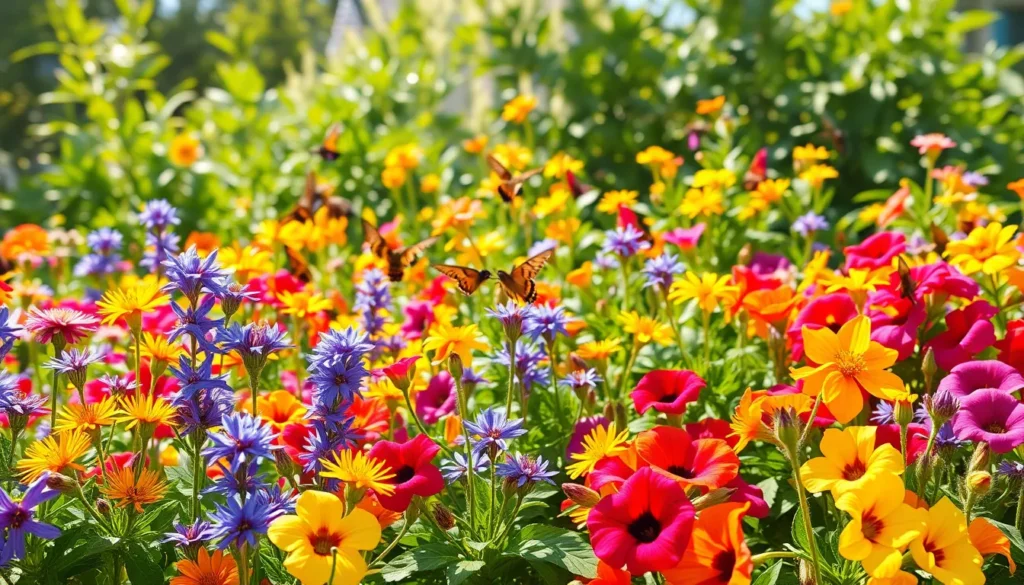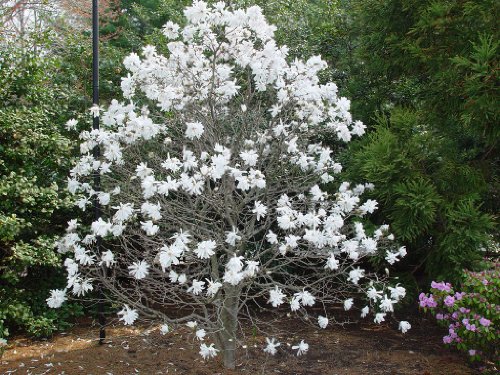We’ve all gazed up at the night sky and marveled at twinkling stars, but nature brings that same celestial magic right to our gardens through star-shaped flowers. These stunning botanical gems create perfect five or six-pointed stars that seem to capture starlight in their delicate petals, transforming ordinary landscapes into enchanting displays.
From the vibrant blue of star-of-Bethlehem to the cheerful yellow of evening primrose, star-shaped blooms offer gardeners an incredible variety of colors, sizes, and growing conditions. Whether you’re looking to create a themed garden or simply add some geometric beauty to your outdoor space, these flowers deliver both visual impact and symbolic meaning.
We’ll explore the most popular star-shaped flowers that’ll make your garden shine, including easy-care options for beginners and show-stopping varieties for experienced gardeners. You’ll discover how these cosmic-inspired blooms can elevate any industry design while attracting beneficial pollinators to your yard.
Petunia: The Classic Star-Shaped Garden Favorite
Petunias rank among the most beloved star shaped flowers for good reason. These versatile blooms combine the celestial appeal we’ve been exploring with exceptional garden performance.
Varieties of Star-Shaped Petunias
Grandiflora petunias produce the largest star shaped blooms, measuring 3 to 4 inches across with distinct five pointed petals. Popular varieties like ‘Supercascade’ and ‘Ultra’ series showcase vibrant colors including deep purple, bright pink, and pristine white that form perfect stellar patterns.
Multiflora petunias offer smaller 1.5 to 2 inch star shaped flowers but compensate with abundant blooms throughout the growing season. Wave petunias and ‘Celebrity’ series excel in this category, creating carpets of star shaped blossoms in gardens and containers.
Milliflora petunias deliver the tiniest star shaped flowers at just 1 inch across, making them perfect for intricate garden designs. ‘Fantasy’ and ‘Picobella’ varieties produce hundreds of miniature stellar blooms that create stunning visual impact when planted en masse.
Growing Conditions and Care Tips
Sunlight requirements for star shaped petunias include full sun exposure of 6 to 8 hours daily for optimal flowering. We’ve found that morning sun with afternoon shade works well in extremely hot climates, preventing the delicate star petals from wilting.
Soil preparation involves creating well draining conditions with pH levels between 6.0 and 7.0. Adding compost or aged manure improves soil structure and provides nutrients that enhance the formation of those distinctive star shaped blooms.
Watering techniques focus on deep, infrequent watering at soil level to prevent fungal issues on the star shaped petals. Drip irrigation or soaker hoses work best, delivering 1 to 1.5 inches of water weekly during peak growing season.
Fertilization schedules include balanced liquid fertilizer every 2 weeks throughout the blooming period. High phosphorus fertilizers particularly benefit star shaped flower production, while avoiding excessive nitrogen that promotes foliage over blooms.
Deadheading practices maintain continuous star shaped flower production by removing spent blooms weekly. Pinching off faded flowers at the stem encourages new buds to form, extending the celestial display well into fall.
Star of Bethlehem: The Elegant White Star Bloomer
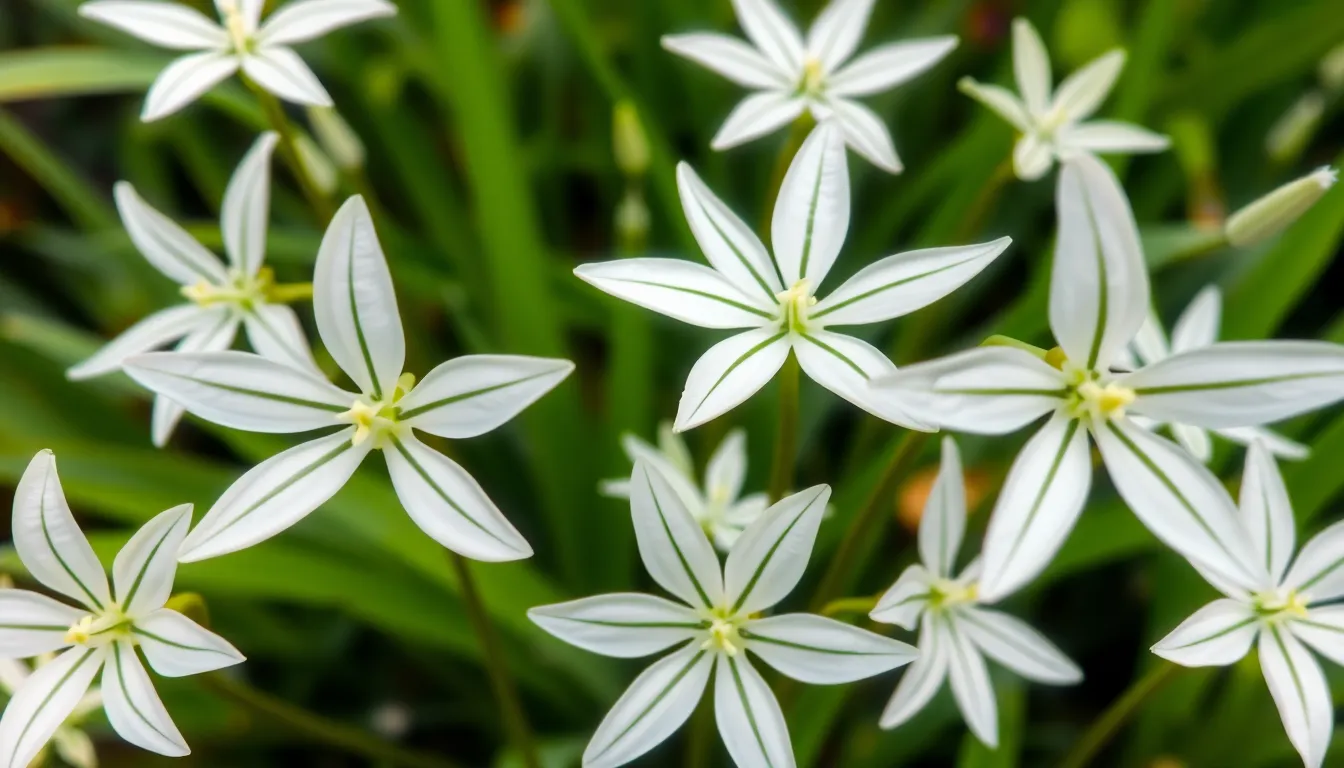
Our journey through star shaped flowers continues with one of nature’s most pristine specimens. Star of Bethlehem (Ornithogalum umbellatum) stands out as a bulbous perennial that delivers stunning white star blooms to gardens across the globe.
Identification and Characteristics
Star of Bethlehem creates unmistakable star shaped flowers through its six bright white tepals that form perfect stellar patterns. Each bloom measures approximately 0.5–0.75 inches in diameter and features distinctive green stripes on the underside of its petal-like segments. These radiant white stars sit atop leafless stalks that reach up to one foot in height, creating an elegant display above the foliage.
The plant’s grass-like leaves are equally distinctive, showcasing dark green coloration with prominent white midribs running through their centers. These narrow, smooth leaves are hollow in cross-section, making them easy to distinguish from similar plants. Blooming occurs in late spring to early summer, with flowers closing at sunset or during cloudy weather—a fascinating behavioral trait that adds to their mystique.
Native to Europe, the Mediterranean, and North Africa, this star shaped flower has naturalized widely across different continents. Its spreading nature and adaptability have made it a common sight in gardens and naturalized areas worldwide.
Planting and Maintenance Requirements
Successful cultivation of Star of Bethlehem requires exact soil and spacing considerations for optimal bloom production. Plant bulbs 5 inches deep with proper base positioning, spacing them 2–3 inches apart or approximately 20–25 per square foot for dense coverage. This star shaped flower thrives in moist, fertile, well-drained soil conditions that prevent bulb rot while supporting healthy growth.
Light requirements are flexible, as these plants perform well in full sun to partial shade conditions and can tolerate up to 25% shade coverage. Established plants demonstrate remarkable drought tolerance during summer months, though consistent moisture during the growing season promotes better flowering.
Post-bloom care involves allowing natural dormancy cycles, as the plant dislikes heavy late summer rains once it enters its rest period. Propagation occurs naturally through bulb offsets and seed dispersal, though we can divide bulbs manually to create new plantings.
Important safety considerations include the plant’s toxic properties when ingested, requiring caution around children and pets. This star shaped flower’s vigorous spreading habit through both seeds and offsets can lead to invasive behavior in some regions, so monitoring growth patterns helps maintain garden balance.
Star Jasmine: The Fragrant Climbing Star
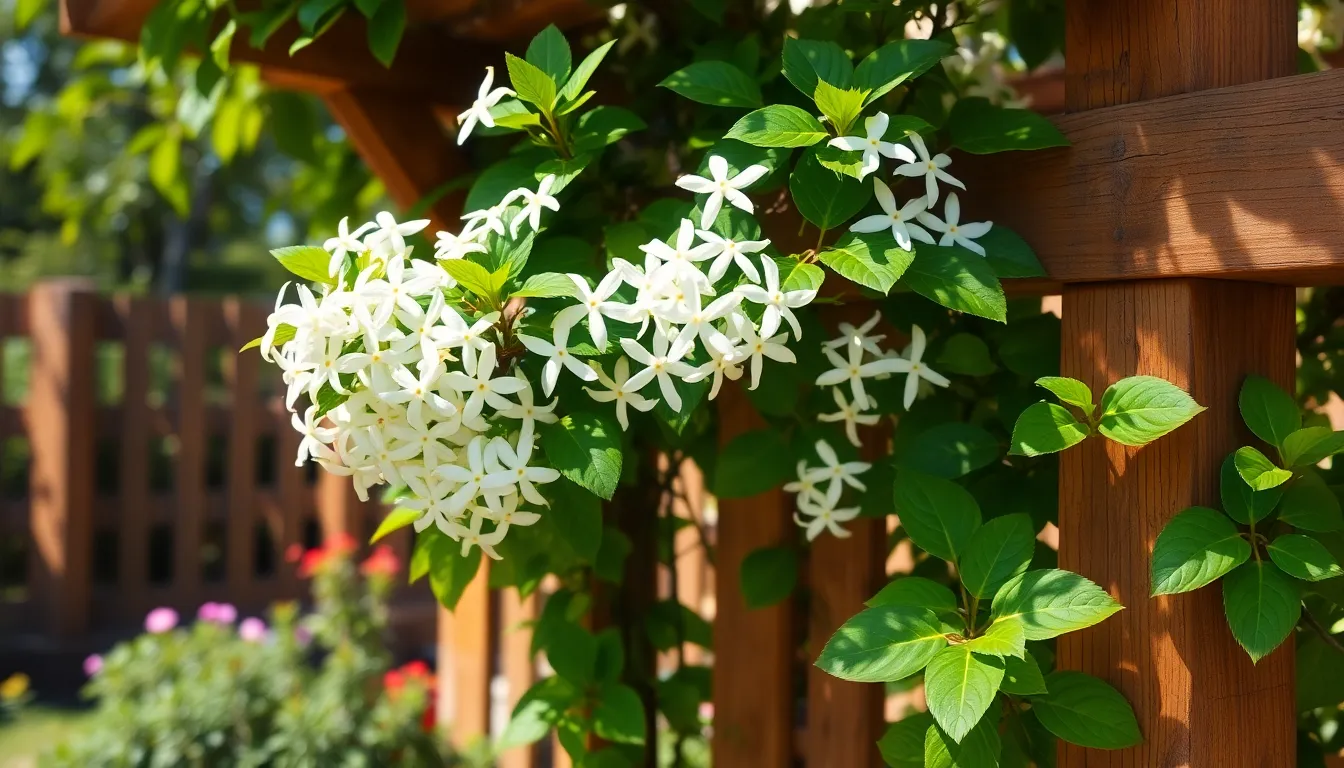
Star jasmine transforms any garden space with its intoxicating fragrance and elegant climbing nature. We recognize this evergreen beauty as one of the most rewarding star shaped flowers for vertical gardening enthusiasts.
Growth Habits and Training Methods
Vigorous climbing characteristics define star jasmine as it reaches impressive heights up to 20 feet tall when properly supported. We recommend establishing your star jasmine against sturdy walls, trellises, or pergolas where it can showcase its natural climbing tendencies.
Well draining soil serves as the foundation for healthy star jasmine growth, preventing root rot and encouraging robust development. Partial shade locations work exceptionally well for this fragrant climber, though it adapts to various light conditions throughout your garden.
Training techniques require consistent attention during the first few growing seasons to establish desired growth patterns. We suggest gently tying new shoots to support structures using soft plant ties, allowing the natural twining habit to take over as the plant matures.
Regular guidance helps maintain the star jasmine’s shape while promoting even coverage across your chosen support structure. Weaving young stems horizontally across trellises encourages fuller flowering displays along the entire climbing surface.
Seasonal Care and Pruning Techniques
Post flowering pruning represents the optimal timing for maintaining your star jasmine’s health and encouraging future blooms. We trim our star jasmine immediately after the flowering period ends to prevent removing next year’s flower buds.
New growth encouragement happens when we remove older, woody stems that no longer produce abundant flowers. Strategic cutting of these mature branches redirects the plant’s energy into fresh, vigorous shoots that will bloom more prolifically.
Growing season maintenance includes consistent watering schedules and regular fertilization to support the star jasmine’s extensive growth habits. We apply balanced fertilizer monthly during active growing periods to maintain healthy foliage and maximize fragrant flower production.
Preventive pruning stops woody stem development before it becomes problematic, keeping your star jasmine manageable and attractive year round. Light trimming throughout the growing season maintains the desired shape while preventing overcrowding that can reduce air circulation and flowering potential.
Pentas: The Tropical Star Cluster Flower
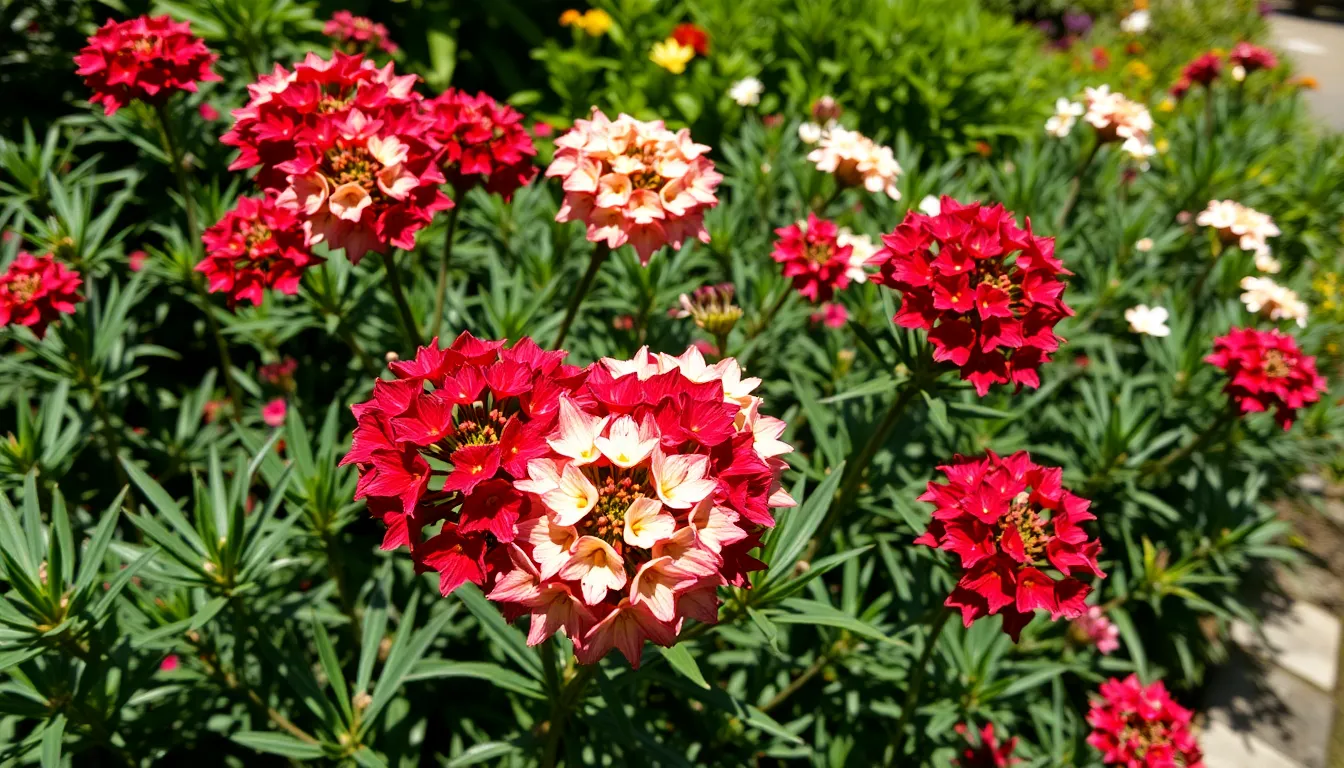
Building on our star-shaped flower collection, we’re excited to introduce Pentas lanceolata, commonly called the Egyptian star flower or star cluster. These tropical beauties produce dense clusters of star-shaped blossoms that create stunning displays in gardens while attracting butterflies and hummingbirds throughout the growing season.
Color Variations and Cultivars
Pentas deliver an impressive spectrum of vibrant colors including red, pink, lavender, purple, and white blooms that brighten any garden space. Popular cultivars like the Starcluster™ and Sunstar® series offer robust, long-lasting flowers in shades ranging from soft rose-pink to deep magenta and crisp white. Many varieties feature contrasting centers that enhance their visual appeal and create striking focal points in mixed plantings.
We particularly appreciate how these star-shaped flowers maintain their vibrant colors even in intense heat, making them reliable performers for summer displays. The dark green lance-shaped foliage provides an excellent backdrop for the colorful blooms while remaining evergreen in mild climates. Different series offer varying growth habits, allowing gardeners to choose compact options for containers or taller varieties for borders and hedging applications.
Indoor and Outdoor Growing Guidelines
Pentas thrive in full sun conditions, requiring at least 6–8 hours of direct sunlight daily for optimal flowering performance. Well-drained soil is essential since these plants don’t tolerate soggy conditions that can lead to root problems. While they’re hardy perennials in USDA zones 10–11, we grow them as annuals in cooler regions where they perform beautifully until frost.
Outdoor cultivation works best in borders, mixed containers, or as informal hedges, though heavy trimming may reduce flowering potential. These star-shaped flowers excel in high heat conditions and require minimal maintenance once established. For indoor growing, provide bright light and consistent moisture while ensuring good air circulation around the plants.
We recommend avoiding heavy pruning during peak growing season to maintain continuous blooms from planting through frost. Pentas are generally deer and rabbit resistant, making them excellent choices for gardens where wildlife browsing is a concern. Keep in mind that these plants shouldn’t be consumed by humans or animals due to their toxic properties.
Star Magnolia: The Early Spring Star Bloomer
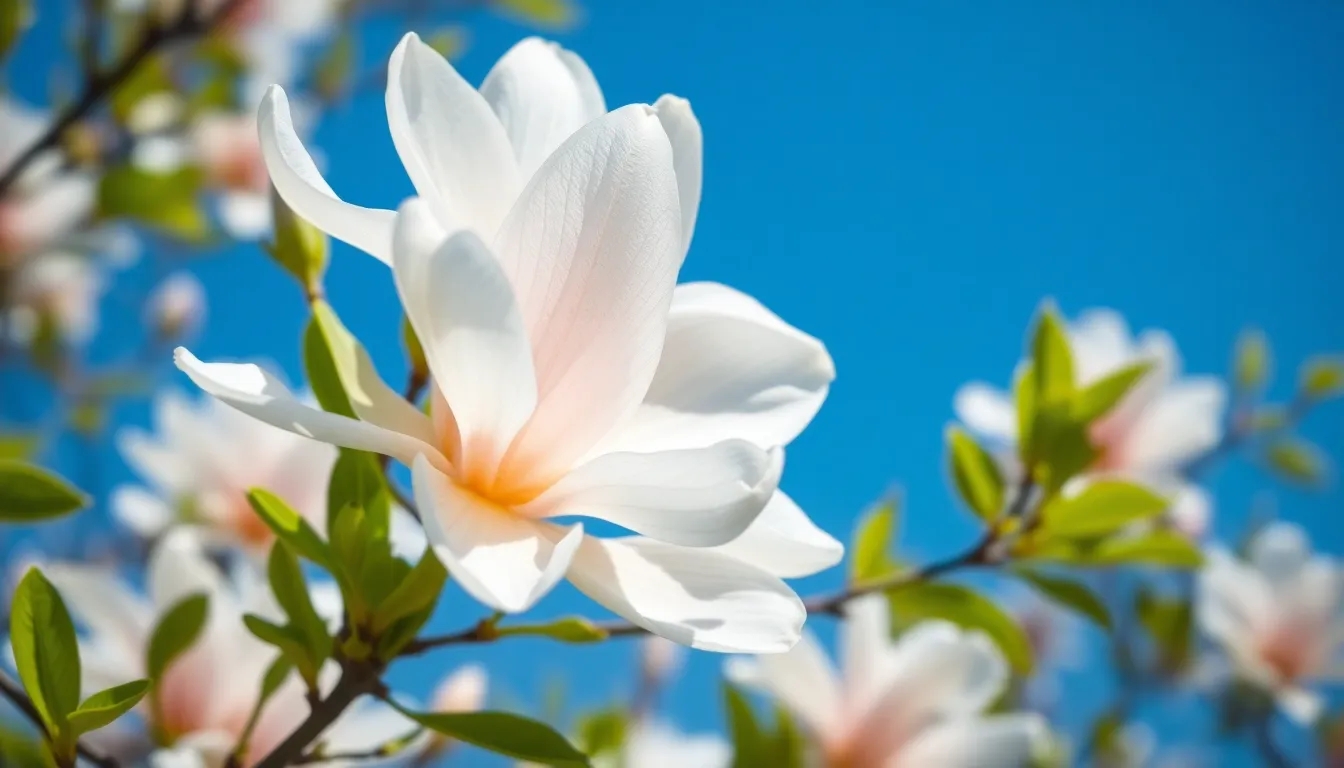
Star Magnolia stands out as one of nature’s most spectacular early bloomers, producing dramatic white or pale pink star shaped flowers when most gardens remain dormant. We’ll explore why this magnificent tree deserves a place in every spring garden design.
Bloom Timing and Duration
Star Magnolia blooms earlier than most flowering trees, typically appearing in late winter to early spring before leaves emerge. This exceptional timing creates maximum ornamental impact when gardens need color most desperately.
Duration spans two to three weeks under normal conditions, though cool and stable weather can extend the flowering period significantly longer. Bloom timing varies slightly among cultivars, but all maintain the signature star shaped pattern that makes this magnolia so distinctive.
Different varieties offer subtle variations in petal count and color intensity, ranging from pure white to pale pink, while preserving the characteristic star formation that attracts early season pollinators.
Industry Design Applications
Specimen placement works best for Star Magnolia since its early blooms create a stunning focal point when positioned prominently in garden beds or lawn areas. We recommend using this tree as the centerpiece of spring garden designs.
Size considerations make Star Magnolia perfect for smaller spaces, reaching 10 to 20 feet tall and wide at maturity, fitting comfortably in foundation plantings or medium sized gardens without overwhelming other plants.
Soil adaptability allows flexible placement options, though Star Magnolia performs best in well drained, slightly acidic soil with partial to full sun exposure for optimal star shaped flower production.
Companion planting opportunities include early bulbs and perennials that bloom consecutively with Star Magnolia, creating layered garden interest that extends the spring color season naturally.
Low maintenance requirements appeal to busy gardeners since Star Magnolia needs minimal pruning and demonstrates excellent pest resistance, making it ideal for sustainable industry designs focused on star shaped flowers.
Aster: The Fall-Blooming Star Shaped Flowers
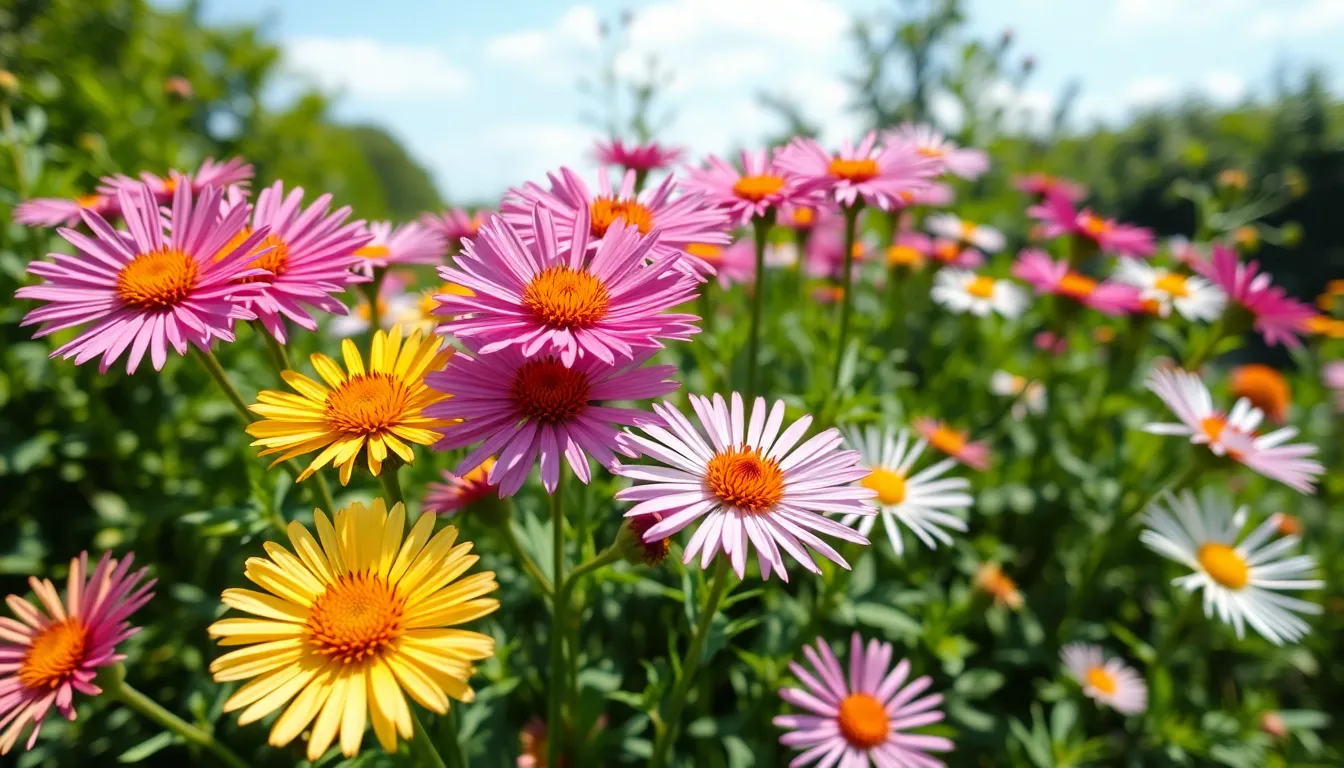
Asters bring the magic of star shaped flowers to our gardens when most other blooms are fading. These reliable perennials create stunning displays from late summer through fall with their distinctive radiating petals.
Native vs. Cultivated Varieties
Native asters offer gardeners a more sustainable approach to fall star shaped flowers. Their smaller, delicate blooms create naturalistic displays that require minimal maintenance once established. Natural resistance to local pests and diseases makes them perfect for low-maintenance landscapes. We find these varieties particularly valuable for supporting native pollinators and maintaining ecological balance.
Cultivated varieties provide gardeners with enhanced visual impact through larger, more vibrant star shaped flowers. Breeding programs have developed these ornamental selections to produce showier blooms in intense colors. Maintenance requirements tend to be higher since these varieties may need more water, fertilizer, and pest management. Garden centers typically stock these improved cultivars for homeowners seeking maximum decorative effect.
Companion Planting Strategies
Beneficial insect attraction becomes effortless when we pair asters with plants that support pollinators. Combining these star shaped flowers with native grasses creates movement and texture while providing habitat for beneficial insects. Sedums planted nearby extend the blooming season and offer nectar sources for late-season butterflies and bees.
Pest deterrent companions help protect our aster displays from common garden problems. Marigolds planted around aster beds repel nematodes and other soil-dwelling pests that can damage root systems. Basil serves double duty by deterring aphids while providing culinary herbs for our kitchens.
Aromatic partnerships enhance both pest control and garden fragrance around star shaped flowers. Lavender planted near asters helps deter moths and other unwanted insects while creating pleasant scented garden areas. Rosemary provides year-round structure and pest-repelling properties that complement the seasonal nature of aster blooms.
Star Flower (Ipheion): The Delicate Miniature Star
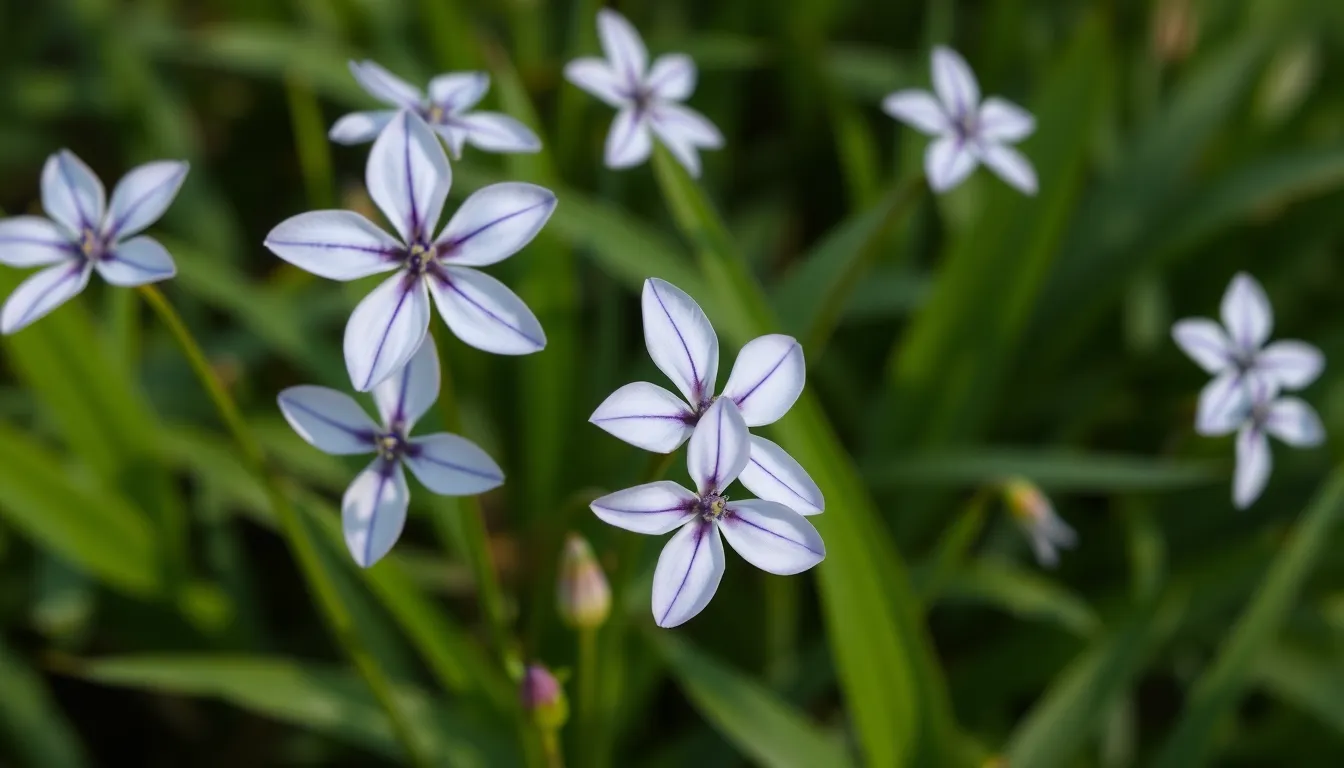
Moving from the larger blooms we’ve explored, we discover the charming Ipheion uniflorum, a spring starflower that brings delicate beauty to our gardens. This bulbous perennial produces solitary star shaped flowers measuring about 1.5 inches in diameter, featuring six petals with dark central veins and colors ranging from white with blue tinges to violet blue.
Bulb Planting and Care
Autumn planting sets the foundation for spectacular spring displays when we plant Ipheion bulbs. We position each bulb 2-3 inches deep in well drained soil, spacing them 3-4 inches apart to allow proper development. Full sun to partial shade locations work best for these adaptable plants, which tolerate various soil types once established.
Minimal maintenance requirements make Ipheion ideal for busy gardeners seeking low effort beauty. We water regularly only during extended dry periods, as these drought resistant bulbs handle most weather conditions independently. Spring to early summer blooming periods reward us with fragrant star shaped flowers that require no special fertilization or intensive care routines.
Naturalization in Garden Settings
Garden beds and borders provide perfect settings where Ipheion bulbs establish thriving colonies over time. We plant them under trees and shrubs where their low growing habit complements taller specimens without competing for space. Natural spreading occurs through offsets, creating attractive clumps that return annually with increasing flower displays.
Rock gardens and edging applications showcase Ipheion’s versatility in industry design, where we use their compact size to define pathways and garden sections. Mixed perennial plantings benefit from these early spring bloomers, which provide essential color when few other plants flower. Naturalization success depends on choosing locations with good drainage, where established colonies expand gradually without becoming invasive or overwhelming nearby plants.
Starflower Borer: The Unique Woodland Star
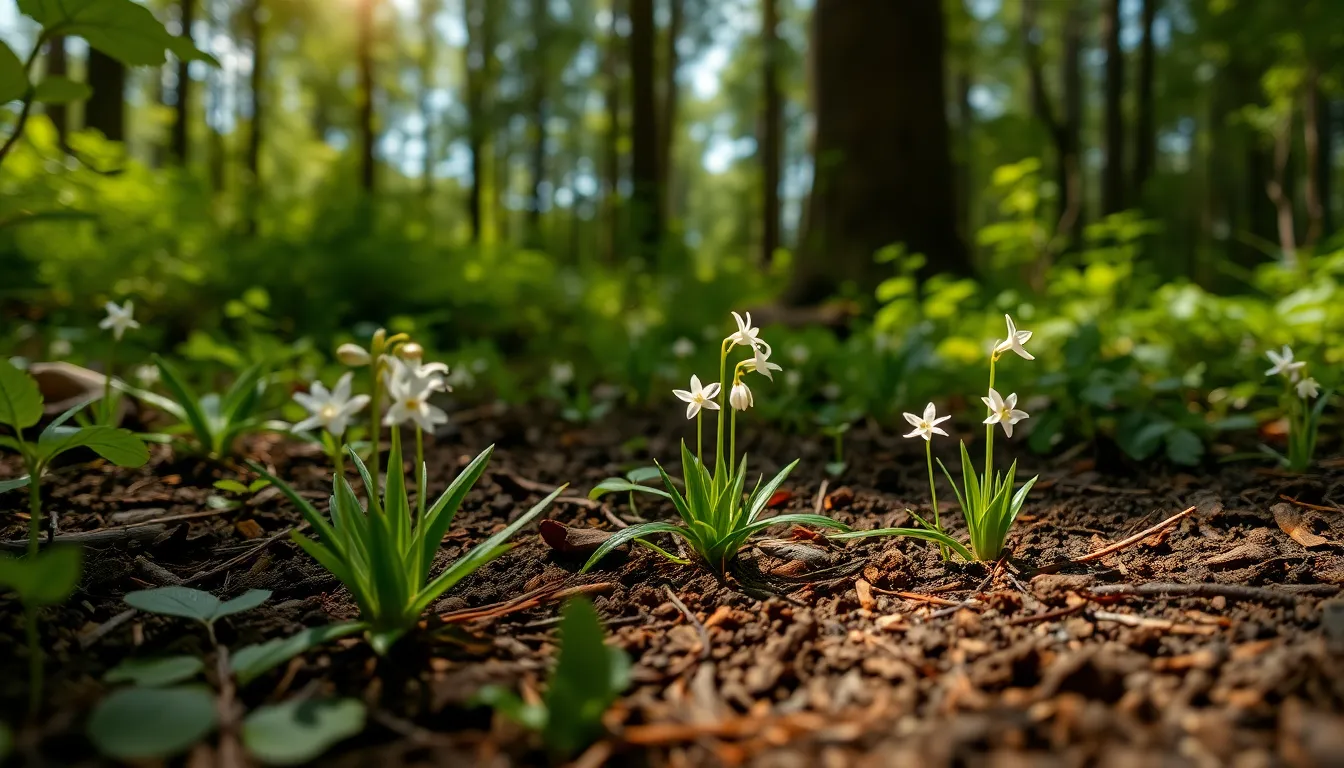
The Starflower Borer represents one of North America’s most enchanting woodland perennials, scientifically known as Trientalis borealis or Lysimachia borealis. We celebrate this delicate native species for its distinctive white star-shaped blooms that grace forest floors from May through June.
Natural Habitat Requirements
Woodland environments provide the perfect sanctuary for Trientalis borealis to flourish and establish robust colonies. We find these charming perennials thriving in shaded areas where dappled sunlight filters through forest canopies. Moist, well-draining soil rich in organic matter creates the ideal foundation for healthy root development and sustained growth.
Forest edges and understory locations offer the balanced light conditions that starflowers crave for optimal blooming. We recommend mimicking these natural conditions in garden settings by selecting spots with partial to full shade. Consistent moisture levels throughout the growing season support the plant’s shallow root system and encourage vigorous flowering.
pH levels between 5.5 and 7.0 create the slightly acidic to neutral soil conditions that promote healthy starflower colonies. We suggest incorporating leaf mold or compost into planting areas to replicate the nutrient-rich forest floor environment. Protection from harsh winds and intense afternoon sun helps maintain the delicate foliage structure throughout the blooming period.
Propagation Methods
Division stands out as the most reliable propagation technique for establishing new starflower colonies in woodland gardens. We recommend performing division in early spring before active growth begins or in late fall after the foliage dies back. Careful separation of the underground rhizomes ensures each division contains sufficient root material for successful establishment.
Seed propagation offers another viable method for expanding starflower populations, though it requires patience for germination and establishment. We collect fresh seeds immediately after the small capsules ripen in summer for the highest germination rates. Cold stratification for 60 to 90 days mimics natural winter conditions and improves germination success.
Spring sowing directly in prepared woodland beds allows seeds to experience natural temperature fluctuations that trigger germination. We scatter seeds lightly over moist soil and cover with a thin layer of leaf mold or fine compost. Consistent moisture during the germination period, which can extend from several weeks to months, supports successful seedling development.
Egyptian Star Cluster: The Colorful Annual Star
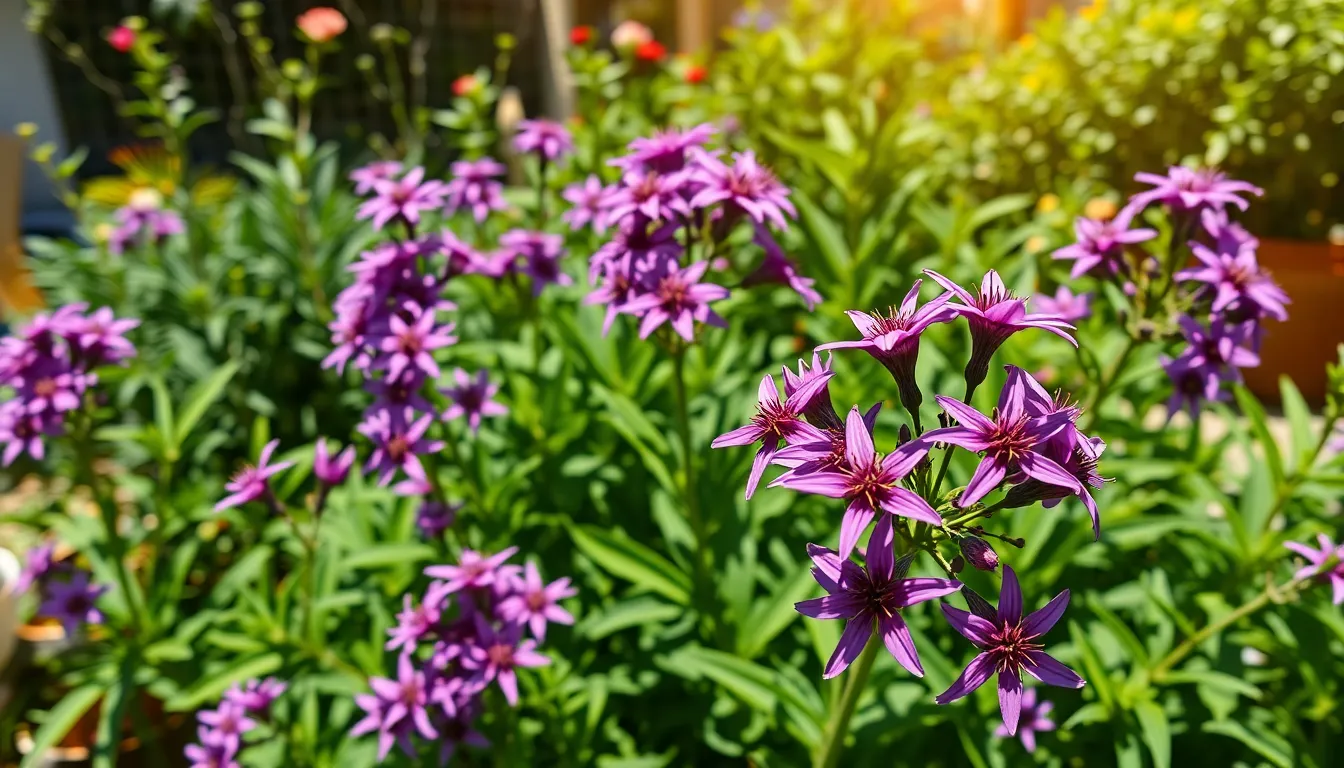
Egyptian Star Cluster stands out as one of the most vibrant additions to our star shaped flower collection. We’ll explore the essential growing techniques that make this tropical beauty thrive in various garden settings.
Seed Starting and Transplanting
Starting seeds indoors gives us the best chance for successful Egyptian Star Cluster cultivation in cooler climates. We recommend beginning the seed starting process 8 to 10 weeks before our last expected frost date to ensure strong, healthy seedlings.
Indoor germination requires consistent temperatures between 65°F and 75°F for optimal results. Seeds typically germinate within 10 to 14 days when provided with adequate moisture and bright, indirect light. We find that using a seed starting mix provides better drainage than regular potting soil.
Transplanting becomes crucial once our seedlings develop their second set of true leaves. Moving them into larger containers allows root systems to expand before outdoor planting. We space transplants 12 to 18 inches apart to accommodate their mature spread of 12 to 24 inches.
Timing our outdoor transplanting correctly prevents cold damage to these tropical natives. Soil temperatures should reach at least 60°F consistently before we move seedlings outside. Gradual acclimatization over 7 to 10 days helps plants adjust to outdoor conditions without shock.
Heat Tolerance and Summer Care
Heat tolerance makes Egyptian Star Cluster exceptional for summer gardens where other flowers struggle. These robust plants actually prefer temperatures between 70°F and 85°F, thriving in conditions that stress many annual flowers.
Full sun exposure for at least 6 hours daily produces the most abundant blooming throughout summer months. Partial shade locations still support healthy growth, though flower production may decrease slightly. We’ve observed that morning sun combined with afternoon shade works well in extremely hot climates.
Regular moisture keeps Egyptian Star Cluster performing at peak levels during summer heat waves. Deep watering twice weekly proves more effective than daily shallow watering for establishing strong root systems. Well drained soil prevents root rot while maintaining consistent moisture levels.
Controlled release fertilizer applied at planting time provides steady nutrition for 3 to 4 months of continuous blooming. Mid summer fertilizer applications boost flower production during the hottest months when plants expend extra energy. We use balanced fertilizers with equal nitrogen, phosphorus, and potassium ratios for best results.
Deadheading becomes unnecessary with Egyptian Star Cluster since flowers naturally drop and new buds form continuously. This self cleaning characteristic saves us considerable maintenance time during busy summer gardening seasons. Container grown plants brought indoors before first frost can overwinter as attractive houseplants.
Star of Persia: The Dramatic Purple Star Bloomer
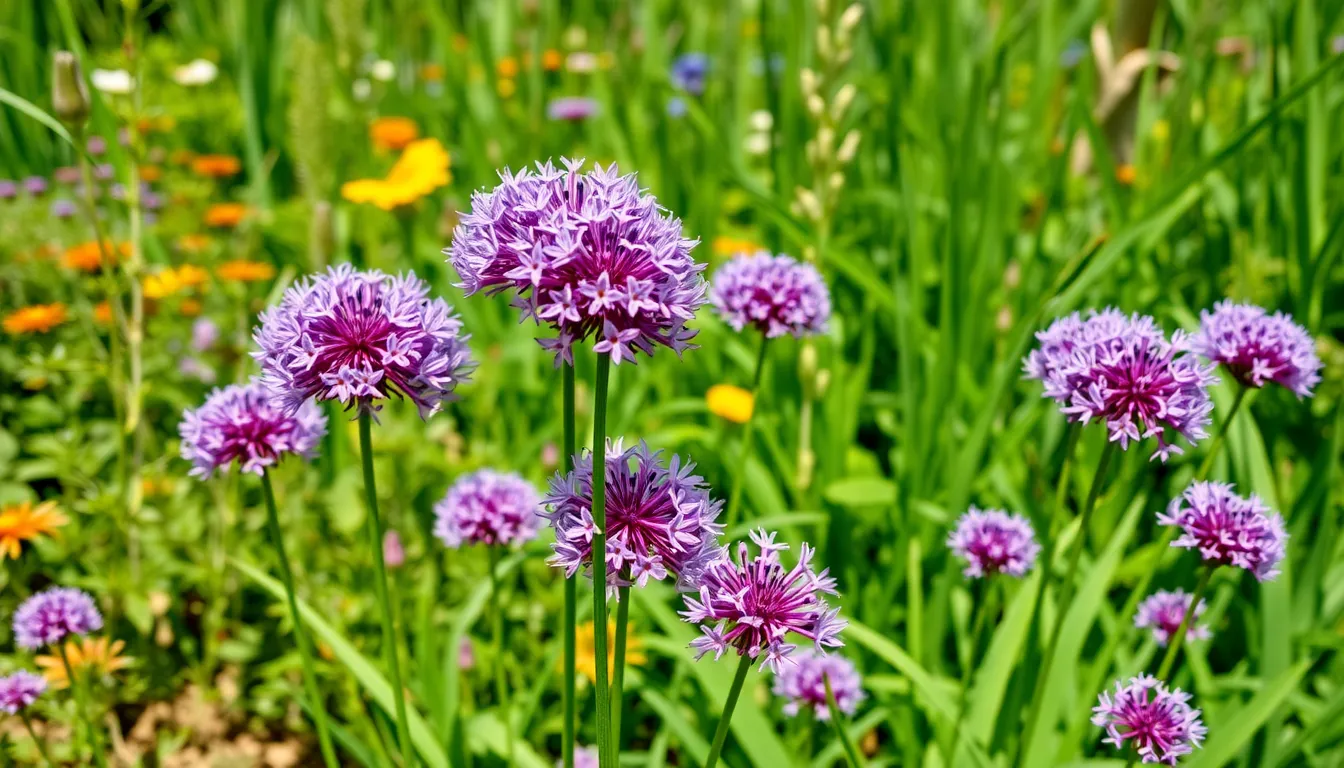
Allium christophii stands out as one of the most spectacular star-shaped flowers we can grow in our gardens. This stunning ornamental onion produces massive flower spheres reaching up to 25 cm in diameter with deep purple star-shaped blooms that create breathtaking focal points.
Allium Family Characteristics
Allium flowers showcase distinctive 6-parted structures that cluster dramatically at the top of naked stems. These bulbous perennials exhibit tubular, bell-shaped, or star-shaped configurations depending on the exact variety we choose for our gardens.
Growing habits make alliums exceptionally appealing for busy gardeners since they require minimal maintenance while delivering maximum visual impact. Cool-season classification means these bulbs establish quickly with rapid growth rates that surprise many first-time growers.
Soil preferences favor well-drained conditions ranging from clay to sandy textures, making alliums adaptable to various garden environments. Full sun exposure brings out the most vibrant colors and encourages the largest flower development we can expect from these ornamental onions.
Erect growth patterns create clean vertical lines that complement other garden plantings while maintaining their architectural presence throughout the growing season.
Designing with Ornamental Onions
Allium hollandicum offers spherical umbels filled with purple to reddish-purple star-shaped flowers that create stunning mid-border displays. These varieties bloom in late spring, providing perfect timing to bridge the gap between early spring bulbs and summer perennials.
Allium moly brings golden-yellow star-shaped blooms that brighten shaded garden areas where other flowering plants struggle to perform. Compact size makes this variety ideal for rock gardens, container plantings, and front-of-border positions.
Cut flower arrangements benefit tremendously from ornamental onions since their unique star-shaped forms add architectural interest to bouquets. Long-lasting qualities mean these flowers maintain their dramatic appearance for extended periods in vases.
Formal border designs incorporate alliums as punctuation marks that draw the eye through planted spaces. Naturalistic landscapes use these star-shaped flowers to create drifts of color that mimic wild meadow plantings.
Companion planting opportunities expand when we pair ornamental onions with late-blooming tulips, early roses, and emerging perennial foliage that provides contrasting textures.
Conclusion
Star-shaped flowers offer us endless possibilities to transform our gardens into celestial wonderlands. From the fragrant climbing beauty of star jasmine to the dramatic purple spheres of Allium christophii we’ve discovered options for every gardening style and skill level.
These remarkable blooms don’t just add visual appeal—they create thriving ecosystems that support pollinators and beneficial insects. Whether we’re seeking low-maintenance groundcovers like spring starflower or show-stopping specimens like Star Magnolia we can find the perfect match for our garden’s unique conditions.
By incorporating these stellar performers into our industry design we’re investing in year-round beauty that requires minimal effort while delivering maximum impact. Our gardens will thank us with continuous displays of nature’s most enchanting star-shaped treasures.
Frequently Asked Questions
What are the most popular star-shaped flowers for gardens?
The most popular star-shaped flowers include petunias (grandiflora, multiflora, and milliflora varieties), Star of Bethlehem, star jasmine, Pentas (Egyptian star flower), Star Magnolia, asters, spring starflower (Ipheion uniflorum), and Allium christophii (Star of Persia). Each offers unique characteristics, colors, and blooming periods to suit different garden styles and preferences.
When do star-shaped flowers typically bloom?
Star-shaped flowers bloom throughout different seasons. Star Magnolia blooms in late winter to early spring, spring starflower and Star of Bethlehem bloom in late spring to early summer, petunias and Pentas bloom throughout summer, while asters provide fall displays. This variety ensures continuous star-shaped blooms across multiple seasons in your garden.
Do star-shaped flowers attract pollinators?
Yes, many star-shaped flowers are excellent pollinator magnets. Pentas attract butterflies and hummingbirds, asters support native pollinators and beneficial insects, while petunias and other varieties also draw various beneficial pollinators. These flowers help create a thriving ecosystem that supports local wildlife and enhances garden biodiversity.
What growing conditions do star-shaped flowers need?
Most star-shaped flowers prefer well-drained soil and vary in sunlight requirements. Petunias and Pentas thrive in full sun, star jasmine prefers partial shade, while woodland varieties like starflower borer need shaded areas. Generally, they adapt to various soil types but benefit from organic matter and proper spacing for optimal growth.
Are star-shaped flowers suitable for beginner gardeners?
Yes, many star-shaped flowers are perfect for beginners. Star Magnolia, native asters, and spring starflower require minimal maintenance. Petunias are versatile and forgiving, while Star of Bethlehem naturalizes easily. These low-maintenance options allow novice gardeners to enjoy beautiful star-shaped blooms without extensive care requirements.
How do I care for star-shaped flowers throughout the season?
Care varies by species but generally includes regular watering (avoiding overwatering), deadheading spent blooms, and seasonal fertilization. Star jasmine needs post-flowering pruning, while petunias benefit from regular deadheading. Most varieties are relatively low-maintenance once established, requiring basic garden care practices for optimal performance.
Can star-shaped flowers be grown in containers?
Yes, many star-shaped flowers adapt well to container growing. Petunias, Pentas, and smaller varieties like spring starflower work excellently in pots and planters. Container growing allows better control over soil conditions and placement, making it easier to meet specific light and drainage requirements for different species.
Are any star-shaped flowers toxic or invasive?
Some star-shaped flowers have considerations. Star of Bethlehem can be invasive in certain regions and is toxic to humans and animals. Pentas are also toxic if ingested. Star of Bethlehem’s spreading nature requires monitoring in some areas. Always research local regulations and plant characteristics before adding new species to your garden.

